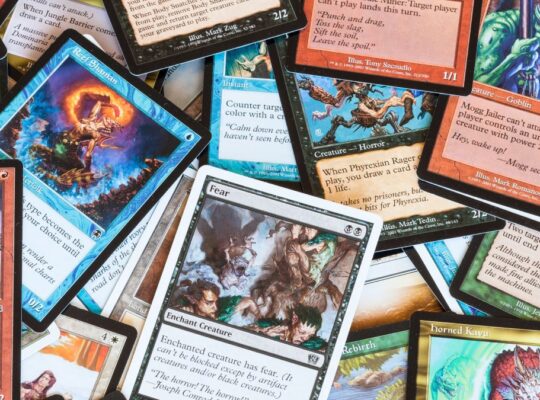Cascade is a dynamic and game-changing mechanic in Magic: The Gathering (MTG) that can turn the tide of a match with its unpredictable nature. Introduced in the Alara Reborn set, Cascade has become a favorite among players for its ability to provide card advantage and unexpected plays.
How does Cascade work?
Cascade operates in a unique and exciting way. Here’s a step-by-step breakdown of how this mechanic functions:
- Step 1: A player casts a spell with Cascade.
- Step 2: After casting the spell, the player then exiles cards from the top of their library until they exile a nonland card that costs less than the spell with Cascade.
- Step 3: The player may cast the exiled card without paying its mana cost.
- Step 4: The remaining exiled cards are put on the bottom of the library in a random order.
This process introduces an element of surprise and strategy, as players can potentially cast powerful spells for free, depending on their deck’s construction.
How to play with Cascade

(Image Credit: Brian Valeza, Wizards)
Playing with Cascade in Magic: The Gathering not only adds an element of surprise but also requires strategic deck building to maximize its potential. Here’s a step-by-step guide on structuring a deck around Cascade and using it to your advantage:
- Identify Your Strategy: Decide on the primary goal of your deck. Cascade can support various strategies, from aggressive creature-based decks to control or combo decks. Your strategy will guide your card selection.
- Select Your Cascade Cards: Include a mix of cards with the Cascade mechanic. Choose ones that align with your strategy. For example, Bloodbraid Elf for aggression or Ardent Plea for a more controlling approach.
- Balance Your Mana Curve: Cascade triggers cards that cost less than the original spell. Ensure your deck has a balanced mana curve with a good spread of lower-cost spells to maximize Cascade’s effectiveness. Avoid too many high-cost spells to reduce the chance of whiffing on a Cascade trigger.
- Incorporate Cascade Targets: Choose nonland cards with lower mana costs that provide value when cast for free. These include spells with instant or sorcery effects, like removal, card draw, or counterspells.
- Synergize with Cascade: Include cards that synergize with casting multiple spells or with the Cascade mechanic. Cards that benefit from casting spells, like prowess creatures or spells with storm, can be particularly effective.
- Plan for Consistency: Since Cascade is somewhat random, include card selection and draw spells to help find your key Cascade cards or to set up your next Cascade.
- Consider Interaction and Control: Include interaction spells (like counterspells or removal) to handle opponents’ threats. These also serve as good Cascade hits in a game.
- Testing and Refining: Playtest your deck. Cascade’s randomness means it’s crucial to tweak your deck based on performance. You might find the need to adjust your mana curve, add more interaction, or change your Cascade targets.
- Playing the Deck: In-game, strategically time your Cascade spells. Use them when they can have the most impact, whether that’s developing your board early or swinging a game in the late stages. Be mindful of the potential outcomes based on your current mana situation and remaining deck composition.
- Adapt to the Game State: Be flexible and adapt your playstyle based on the game’s state. Cascade can lead to unexpected turns, so be prepared to shift your strategy accordingly.
Building a deck around Cascade in MTG is a balancing act between embracing the mechanic’s randomness and ensuring enough consistency to execute your game plan. The excitement of Cascade lies in its unpredictability, but with a well-structured deck, you can tilt the odds in your favor.
Cards with Cascade in MTG
Playing with Cascade effectively requires a deck built to maximize the potential of exiling a high-impact spell. Here’s a list of the top 10 cards with Cascade, each offering unique benefits:
- Maelstrom Wanderer: A powerhouse in Commander, granting all your creatures haste and boasting two Cascade triggers.
- Apex Devastator: This card cascades four times, potentially flooding the board with spells.
- Bloodbraid Elf: A staple in aggressive decks, this card offers both a solid creature and a free spell.
- Shardless Agent: Popular in eternal formats for its ability to provide card advantage while presenting a board presence.
- Ancestral Vision: While not having Cascade itself, it’s a common target for Cascade spells due to its powerful draw effect without a mana cost.
- Ardent Plea: Used in enchantment-based decks, it offers an early game Cascade trigger.
- Violent Outburst: Common in combo decks, this instant not only cascades but also buffs your creatures.
- Yidris, Maelstrom Wielder: A commander that grants Cascade to other spells, turning each spell you cast into a potential chain of spells.
- Etherium-Horn Sorcerer: A reusable Cascade effect since it can return to your hand, offering flexibility and repeated value.
- Captured Sunlight: Offers both life gain and a free spell, useful in slower, more controlling decks.
When playing with Cascade, consider the range of mana costs in your deck. You want a good mix of high-impact and lower-cost spells to maximize your chances of cascading into something beneficial. Remember, the unpredictability of Cascade can work for or against you, so building your deck to harness its chaos is key to success.
That’s as much as we have on Cascade, one of the most interesting mechanics in MTG. You might also be interested in Explore, or Connive, two other keywords we’re excited to babble on about.



